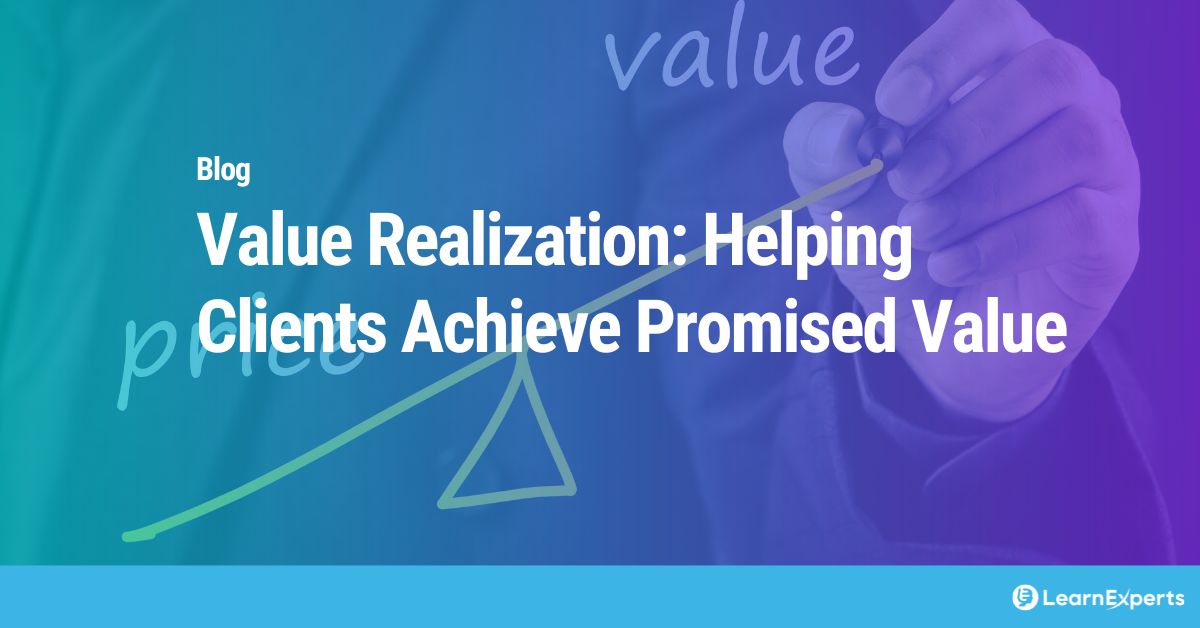A critical aspect of any customer success manager’s (CSM) role is helping clients generate measurable value from their purchased solutions. Value realization is the only way to motivate customers to renew, increase their existing service contracts (upsell), or make additional product or service purchases (cross-sell).
From the customer’s perspective, the value realization stage is also critical since it is the stage that they start to see a return on investment from their purchase.
Promised and anticipated value
During pre-sales, marketing teams explain the product or service in the best possible light. The sales or account manager positions the offer as appropriate for meeting the customer’s needs and desires.
But promises are different from expectations.
In the first phase of value realization, the CSM should check with sales and account management to remind themselves of the conversations with the client, including what was promised, what wasn’t promised, and the value that may be achieved with the solution.
Once CSMs have checked in with their internal teams, the next important step is agreeing with the client on how the solution will deliver value. The first and most important is the fulfillment of all promises made (“must haves”), and the second is the additional values that were proposed as possible to achieve (“nice to haves”).
It is important to document the items in both categories at the start of CSM’s engagement and, where necessary, validate them with internal and customer stakeholders.
Determining value generated
Value can be divided into direct benefits (or tangible value) and indirect benefits (or intangible value).
A direct benefit is any value that can be shown to influence the company’s finances directly. Because they directly influence the company’s finances, it is easy for the company to calculate their financial value. Often, it is calculated by factors such as an increase in price, reduced costs, reduced time to perform tasks and additional sales (revenue).
Indirect benefits often extend beyond immediate ROI and can impact the customer’s organization in the long-term.
- Improved customer satisfaction: A product may enhance the end-user’s experience, leading to higher satisfaction and loyalty.
- Brand reputation: The product or service may lead to higher sales or improved relationships with partners, clients, or the market.
- Operational efficiency: The solution may streamline processes, provide more data insights, eliminate redundant tasks, reduce workload, and increase employee productivity.
- Employee retention and collaboration: A product may make employees’ jobs easier, more fulfilling or improve communications, thereby improving morale, increasing collaboration and reducing turnover.
- Compliance and risk reduction: Greater compliance with regulatory requirements could reduce the risk of fines or legal issues.
- Scalability and flexibility: A product or service may allow the client to scale operations or adapt to new business requirements.
- Innovation enablement: Implementing a new solution may foster a culture of innovation within the customer’s organization, encouraging further technological advancements.
By analyzing these multifaceted benefits, organizations can ensure they fully capture the value of their initiatives and make informed decisions about future investments in the solution.
Selecting KPIs for value realization
Key Performance Indicators (KPIs) help measure the tangible and intangible benefits customers receive from the product or solution. More indicators mean more work in data collection, analysis, and reporting. Still, assuming they are well-selected, they will provide a more accurate and multidimensional illustration of the value being realized.
The first step is to get the customer to agree on a well-defined outcome that incorporates these three aspects and, ideally, to agree not just on the outcome but also on breaking down that outcome into significant milestones that we can use to determine the quality and pace of progress.
KPIs that may be used include:
- ROI (Return on Investment): The financial return generated by the product or solution relative to the investment cost.
- Time to Value (TTV): Time to begin realizing measurable benefits after implementation.
- Cost savings: Direct savings in labour, maintenance, waste, or operational expenses after implementing the solution.
- Customer Satisfaction (CSAT): End-user satisfaction and its impact on their business.
- Product Adoption Rate: How many users or departments actively use the product or solution.
- Increased efficiency: Improvements in processes, such as reduced time to complete tasks, fewer errors, or better use of resources.
- Revenue impact: Impact on customer’s revenue streams.
- Compliance and risk reduction: How the solution meets regulatory or industry standards and reduces potential risks.
The above are examples and depend very much on what the client wants to achieve and what they value.
By carefully selecting a balanced set of KPIs, organizations can create a clear roadmap to assess whether the project is truly driving the intended value and where adjustments might be necessary to maximize success.
Challenges (+ solutions) during value realization phase
The value realization phase is the only phase where the customer gets anything back from their investment in a solution. It is also one of the most complex parts to get right.
One reason it’s the most challenging phase is because it requires a good understanding of the customer’s unique vision and strategies, business needs and capabilities, and internal infrastructure. With these in mind, these are some of the top challenges during the value realization phase and tips on overcoming them.
Unclear or misaligned goals
Every initiative is different, but there are some commonalities. First, customers will only invest in your company’s solutions if they believe that doing so will benefit them—like selling more products, making processes more efficient, reducing energy consumption, providing better data for business decision-making or meeting new legislative or compliance requirements.
Unclear or misaligned goals can significantly undermine the success of any initiative.
Unclear goals can result in teams working toward different outcomes. Misalignment can skew efforts toward achieving outcomes that may seem beneficial in the short run but fail to support the organization’s broader vision.
Ultimately, unclear or misaligned goals lead to poor decision-making, diminished value realization, and difficulty justifying the project’s success, resulting in missed opportunities for growth and improvement.
To avoid these pitfalls, it’s essential to establish clear, aligned, and well-communicated goals from the start that are aligned with stakeholders’ expectations.
Data collection issues
Gathering accurate data to measure the impact or value of meeting goals can be difficult. Data collection issues include everything from inconsistent data sources to inaccurate data entry, inadequate baseline data, delayed data collection, data fragmentation, bias in data collection, lack of stakeholder investment, non-standardized data measurement, and resistance to data sharing.
To resolve data collection issues, it’s essential to establish robust processes and governance mechanisms, including:
- Standardize data collection processes: Agree on standardized methods for collecting data across all teams and departments. Create templates, guidelines, and data dictionaries to ensure data entry and reporting consistency, minimize data formats and definition discrepancies, and facilitate data consolidation and analysis.
- Automate data collection: Automation reduces the risk of human error and ensures that data is consistently collected. Work with the client to implement as much automation as possible to allow for more reliable tracking of value realization.
- Set up a centralized data repository: Use a centralized platform, location or data warehouse to integrate data from different sources. This will prevent fragmentation and silos and allow a unified value store.
- Conduct regular data audits: Review the data regularly to identify inconsistencies, errors, or gaps. This allows for early detection of problems in the data collection process.
- Implement data governance and ownership: Designate data stewards responsible for maintaining data quality and resolving issues.
- Ensure adequate baseline data collection: Before project implementation, invest time in gathering comprehensive baseline data against which future performance can be measured. Solid baseline data provides a clear point of comparison during the value realization phase.
Time lag between implementation and value realization
There can be a significant delay between when an initiative is implemented and when the value is fully realized. This can lead to impatience or pressure from stakeholders who expect immediate results.
To overcome this challenge, set expectations early about the timeline for value realization. Segmenting value realization into short-, medium-, and long-term gains should also be considered, and intermediate milestones should be used to demonstrate progress.
Another potential solution is to use predictive analytics to forecast the timing of value realization based on historical data, trends, and leading indicators. This helps anticipate when benefits will be realized and manage expectations accordingly.
Change management resistance
Employees or stakeholders may resist changes in workflows, technologies or processes to realize value from a new solution.
Overcoming change management resistance requires a thoughtful, people-centred approach. Employees may worry about how changes affect their jobs, workload, or sense of competence. To mitigate this, collaborate with clients to communicate the reasons behind the changes, how these changes align with the organization’s broader goals, and, most importantly, what benefits the employees will derive from the change.
This means more than just sending out emails or conducting one-time meetings. Work with the client to engage in two-way dialogue with employees, allowing them to voice concerns, ask questions, and feel heard.
Equally important is training and support to help employees adjust to the new systems or processes. Resistance often arises when people feel unprepared or unequipped to handle new tasks. By offering robust training programs, hands-on practice, and continuous learning opportunities, employees will build the skills and confidence they need to adapt.
Another tactic to consider is identifying and empowering change champions within the organization—individuals who are enthusiastic about the change and can positively influence their peers. These champions can help bridge the gap between leadership and staff by serving as role models and demonstrating the benefits of the changes in action.
Finally, celebrate small wins along the way. As progress is made and early benefits of the changes materialize, recognizing these successes can help shift attitudes from skepticism to optimism.
Underutilization of capabilities
Often, the organization does not utilize the full range of features or services, which limits the value that can be realized. This can be due to a lack of awareness, training, or the complexity of the solution. Ensure thorough and frequent training and support so users understand and use all available features and capabilities.
Difficulty in quantifying intangible benefits
Many benefits realized from initiatives can be intangible, such as improved employee morale, better customer satisfaction, or brand reputation. These are difficult to measure and quantify in traditional financial terms.
To overcome this challenge, use proxy metrics, qualitative feedback, and innovative approaches to track and report on intangible benefits.
Unanticipated changes or external factors
External factors such as market conditions, regulatory changes, or economic shifts can disrupt or diminish the value realized from a project.
To help manage unplanned events, develop a robust risk management framework to anticipate changes affecting value realization, such as economic downturns, regulatory changes, or supply chain disruptions.
Next, prepare contingency plans with alternative approaches. This might involve setting aside resources, securing backup suppliers, or creating alternative project timelines. Continually assess risks throughout the project life cycle and use agile project management or adaptive business models that can pivot quickly in response to external pressures.
Finally, deliver value in smaller increments to minimize the impact of external changes and adjust to reflect current realities.
Stakeholder alignment and buy-in
Value realization often requires continued stakeholder support and commitment, which can wane over time if competing priorities or new leadership are present. Maintain regular communication and reporting to ensure ongoing alignment and engagement throughout the value realization phase.
Scope creep for value realization
Changes in the scope of a project or initiative can affect value realization by diverting focus and resources or altering the expected outcomes.
Clearly define and document the project scope at the outset, including goals, deliverables, timelines, and boundaries. A detailed scope helps all stakeholders understand the intended outcomes and limits.
Implement strong project management practices for handling any requested changes during value realization. This process should include evaluating the impact on cost, timeline, and resources before approving any changes. Ensure all changes go through a proper approval process involving key decision-makers. Finally, keep a record of all changes to the scope, including the rationale behind them and their effects on the project. This helps maintain clarity and transparency.
One last tip: regularly review the alignment between project activities and value realization goals to ensure everyone is on the same page.
How LEAi helps with value realization
LEAi can be an effective customer success tool to aid in the value realization phase of a project, particularly when it involves creating training content, documentation, or onboarding materials for teams and stakeholders. Here’s how LEAi can be leveraged during the value realization phase:
Automate content creation: LEAi can automatically generate training materials like eLearning, documentation, and knowledge assets based on the data and information collected during earlier phases of the project. This reduces the time and effort required to create materials, enabling faster onboarding, continuous training and efficient deployment of resources that support value realization.
Continuous training updates: LEAi can automatically update training materials as processes or products evolve. This ensures that all teams remain aligned with the latest information and can adopt new changes seamlessly.
Updating and maintaining documentation: New insights and changes may emerge throughout the value realization phase. LEAi can continually update existing documentation to reflect the latest best practices, ensuring that all relevant knowledge is captured and updated.
Ensure consistency and accuracy: The AI feature in LEAi helps ensure consistency across all training materials and documentation, reducing errors or discrepancies that might arise from manual documentation processes. Consistent knowledge transfer improves efficiency and adoption.
If you are responsible for ensuring that customers get the value they need from your solutions and you need a tool to help you create training and documentation, contact us. LEAi just may be the tool for you!




